Research on Formation Control Method of Heterogeneous AUV Group under Event-Triggered Mechanism †
Abstract
:1. Introduction
- A distributed event-triggered communication mechanism is proposed to make each AUV communicate only when its own state is updated.
- Solve the cooperative control problem of HEAUVs, which can make the state of all AUVs consistent while saving computing resources and communication bandwidth.
- When analyzing the minimum event trigger interval, a sufficient condition of the trigger condition is obtained. This condition is used to prove that the zeno phenomenon does not occur in the system.
2. Problem Statement
2.1. Dynamics of AUV
2.2. Assumptions and Lemmas
3. Controller Design
3.1. Event-Triggered Controller for HOAUVs
3.2. Event-Triggered Controller for HEAUVs
4. Simulation and Analysis
4.1. Simulation of HOAUVs under Event-Triggered Control
4.2. Simulation of HEAUVs under Event-Triggered Control
5. Conclusions
Author Contributions
Funding
Institutional Review Board Statement
Informed Consent Statement
Data Availability Statement
Acknowledgments
Conflicts of Interest
Abbreviations
| AUV | Autonomous Underwater Vehicle |
| HOAUVs | Homogeneous AUV swarm |
| HEAUVs | Heterogeneous AUV swarm |
References
- Raanan, B.Y.; Bellingham, J.G.; Zhang, Y.; Kemp, M.; Kieft, B.; Singh, H.; Girdhar, Y. Automatic fault diagnosis for autonomous underwater vehicles using online topic models. In Proceedings of the OCEANS 2016 MTS/IEEE Monterey, Monterey, CA, USA, 19–23 September 2016; pp. 1–6. [Google Scholar]
- Su, B.; Wang, H.; Li, N. Event-triggered integral sliding mode fixed time control for trajectory tracking of autonomous underwater vehicle. Trans. Inst. Meas. Control 2021, 43, 3483–3496. [Google Scholar] [CrossRef]
- Al Issa, S.; Kar, I. Design and implementation of event-triggered adaptive controller for commercial mobile robots subject to input delays and limited communications. Control Eng. Pract. 2021, 114, 104865. [Google Scholar] [CrossRef]
- Xiang, X.; Xu, G.; Zhang, Q.; Xiao, Z.; Huang, X. Coordinated control for multi-auv systems based on hybrid automata. In Proceedings of the 2007 IEEE International Conference on Robotics and Biomimetics (ROBIO), Sanya, China, 15–18 December 2007; pp. 2121–2126. [Google Scholar]
- Yu, M.; Yan, C.; Li, C. Event-triggered tracking control for couple-group multi-agent systems. J. Frankl. Inst. 2017, 354, 6152–6169. [Google Scholar] [CrossRef]
- Yue, D.; Tian, E.; Han, Q.L. A delay system method for designing event-triggered controllers of networked control systems. IEEE Trans. Autom. Control 2012, 58, 475–481. [Google Scholar] [CrossRef]
- Liu, W.; Yang, C.; Sun, Y.; Qin, J. Observer-based event-triggered control for consensus of multi-agent systems with time delay. In Proceedings of the 2016 Chinese Control and Decision Conference (CCDC), Yinchuan, China, 28–30 May 2016; pp. 2515–2522. [Google Scholar]
- Antunes, D.J.; Khashooei, B.A. Consistent dynamic event-triggered policies for linear quadratic control. IEEE Trans. Control Netw. Syst. 2017, 5, 1386–1398. [Google Scholar] [CrossRef]
- Bernard, C.; Bouvet, P.J. Multiuser underwater acoustic communication for an auv fleet. In Proceedings of the OCEANS 2019-Marseille, Marseille, France, 17–20 June 2019; pp. 1–5. [Google Scholar]
- Khan, M.T.R.; Ahmed, S.H.; Kim, D. Auv-assisted energy-efficient clustering in underwater wireless sensor networks. In Proceedings of the 2018 IEEE Global Communications Conference (GLOBECOM), Abu Dhabi, United Arab Emirates, 9–13 December 2018; pp. 1–7. [Google Scholar]
- Tao, Q.; Zhou, Y.; Tong, F.; Song, A.; Zhang, F. Evaluating acoustic communication performance of micro auv in confined space. In Proceedings of the 2018 OCEANS-MTS/IEEE Kobe Techno-Oceans (OTO), Kobe, Japan, 28–31 May 2018; pp. 1–6. [Google Scholar]
- Albea, C.; Seuret, A. Time-triggered and event-triggered control of switched affine systems via a hybrid dynamical approach. Nonlinear Anal. Hybrid Syst. 2021, 41, 101039. [Google Scholar] [CrossRef]
- Kindt, P.H.; Ghosh, S.; Chakraborty, S. Configuring loosely time-triggered wireless control software. In Proceedings of the 23th International Workshop on Software and Compilers for Embedded Systems, St. Goar, Germany, 25–26 May 2020; pp. 70–73. [Google Scholar]
- Kyriakakis, E.; Sparsø, J.; Puschner, P.; Schoeberl, M. Synchronizing real-time tasks in time-triggered networks. In Proceedings of the 2021 IEEE 24th International Symposium on Real-Time Distributed Computing (ISORC), Daegu, Korea, 1–3 June 2021; pp. 11–19. [Google Scholar]
- Yang, Y.; Xiao, Y.; Li, T. A survey of autonomous underwater vehicle formation: Performance, formation control, and communication capability. IEEE Commun. Surv. Tutor. 2021, 23, 815–841. [Google Scholar] [CrossRef]
- Kyriakakis, E.; Sparsø, J.; Schoeberl, M. Evaluating a time-triggered runtime system by distributing a flight controller. In Proceedings of the 2021 26th IEEE International Conference on Emerging Technologies and Factory Automation (ETFA), Vasteras, Sweden, 7–10 September 2021; pp. 1–8. [Google Scholar]
- Zhang, X.; Zhao, X. Architecture design of distributed redundant flight control computer based on time-triggered buses for uavs. IEEE Sens. J. 2020, 21, 3944–3954. [Google Scholar] [CrossRef]
- Dong, Y.; Lin, Z. An event-triggered observer and its applications in cooperative control of multi-agent systems. IEEE Trans. Autom. Control 2021. [Google Scholar] [CrossRef]
- Heidari, R.; Khajehzadeh, A.; Eslami, M. A consensus event-triggered control of networked multi-agent systems with non-ideal communication network. Ain Shams Eng. J. 2021, 12, 3783–3790. [Google Scholar] [CrossRef]
- Ju, Y.; Ding, D.; He, X.; Han, Q.L.; Wei, G. Consensus control of multi-agent systems using fault-estimation-in-the-loop: Dynamic event-triggered case. IEEE/CAA J. Autom. Sin. 2021. [Google Scholar] [CrossRef]
- Nandanwar, A.; Dhar, N.K.; Malyshev, D.; Rybak, L.; Behera, L. Stochastic event-based super-twisting formation control for multi-agent system under network uncertainties. IEEE Trans. Control Netw. Syst. 2021. [Google Scholar] [CrossRef]
- Trejo, J.A.V.; Rotondo, D.; Medina, M.A.; Theilliol, D. Observer-based event-triggered model reference control for multi-agent systems. In Proceedings of the 2020 International Conference on Unmanned Aircraft Systems (ICUAS), Athens, Greece, 1–4 September 2020; pp. 421–428. [Google Scholar]
- Wang, H.; Xue, B.; Xue, A. Leader-following consensus control for semi-markov jump multi-agent systems: An adaptive event-triggered scheme. J. Frankl. Inst. 2021, 358, 428–447. [Google Scholar] [CrossRef]
- Zhu, J.W.; Yang, Y.P.; Zhang, W.A.; Yu, L.; Wang, X. Cooperative attack tolerant tracking control for multi-agent system with a resilient switching scheme. Neurocomputing 2020, 409, 372–380. [Google Scholar] [CrossRef]
- Deng, Y.; Liu, T.; Zhao, D. Event-triggered output-feedback adaptive tracking control of autonomous underwater vehicles using reinforcement learning. Appl. Ocean. Res. 2021, 113, 102676. [Google Scholar] [CrossRef]
- Gao, Z.; Guo, G. Fixed-time leader-follower formation control of autonomous underwater vehicles with event-triggered intermittent communications. IEEE Access 2018, 6, 27902–27911. [Google Scholar] [CrossRef]
- Kim, J.H.; Yoo, S.J. Distributed event-driven adaptive three-dimensional formation tracking of networked autonomous underwater vehicles with unknown nonlinearities. Ocean. Eng. 2021, 233, 109069. [Google Scholar] [CrossRef]
- Li, L.; Ho, D.W.; Lu, J. Event-based network consensus with communication delays. Nonlinear Dyn. 2017, 87, 1847–1858. [Google Scholar] [CrossRef]
- Mu, N.; Wu, Y.; Liao, X.; Huang, T. Input time delay margin in event-triggered consensus of multiagent systems. IEEE Trans. Cybern. 2018, 49, 1849–1858. [Google Scholar] [CrossRef]
- Su, B.; Wang, H.; Wang, Y.; Gao, J. Fixed-time formation of auvs with disturbance via event-triggered control. Int. J. Control Autom. Syst. 2021, 19, 1505–1518. [Google Scholar] [CrossRef]
- Su, H.; Wang, Z.; Song, Z.; Chen, X. Event-triggered consensus of non-linear multi-agent systems with sampling data and time delay. IET Control Theory Appl. 2017, 11, 1715–1725. [Google Scholar] [CrossRef]
- Xu, Y.; Li, T.; Tong, S. Event-triggered adaptive fuzzy bipartite consensus control of multiple autonomous underwater vehicles. IET Control Theory Appl. 2020, 14, 3632–3642. [Google Scholar] [CrossRef]
- Heemels, W.P.M.H.; Donkers, M.C.F.; Teel, A.R. Periodic event-triggered control for linear systems. IEEE Trans. Autom. Control 2013, 58, 847–861. [Google Scholar] [CrossRef]
- Hu, Z.; Ma, C.; Zhang, L.; Halme, A.; Hayat, T.; Ahmad, B. Formation control of impulsive networked autonomous underwater vehicles under fixed and switching topologies. Neurocomputing 2015, 147, 291–298. [Google Scholar] [CrossRef]
- Li, Y.; Zhang, P.; Wang, C.; Wang, D.; Wang, J. Distributed event-triggered consensus of multi-agent systems with input delay. IFAC-PapersOnLine 2020, 53, 2550–2555. [Google Scholar] [CrossRef]
- Wang, S.; Cao, Y.; Huang, T.; Chen, Y.; Li, P.; Wen, S. Sliding mode control of neural networks via continuous or periodic sampling event-triggering algorithm. Neural Netw. 2020, 121, 140–147. [Google Scholar] [CrossRef]
- Wang, Y.; Gu, Y.; Xie, X.; Zhang, H. Delay-dependent distributed event-triggered tracking control for multi-agent systems with input time delay. Neurocomputing 2019, 333, 200–210. [Google Scholar] [CrossRef]
- Andonie, R. Hyperparameter optimization in learning systems. J. Membr. Comput. 2019, 1, 279–291. [Google Scholar] [CrossRef] [Green Version]
- Lazo, P.P.L.; Cabarle, F.G.C.; Adorna, H.N.; Yap, J.M.C. A return to stochasticity and probability in spiking neural p systems. J. Membr. Comput. 2021, 3, 149–161. [Google Scholar] [CrossRef]
- Chen, K.; Luo, G.; Zhou, H.; Zhao, D. An improved event-triggered control method based on consistency algorithm in heterogeneous auv swarm under communication delay. In Bio-Inspired Computing: Theories and Applications; Pan, L., Cui, Z., Cai, J., Li, L., Eds.; Springer: Singapore, 2022; pp. 206–221. [Google Scholar]
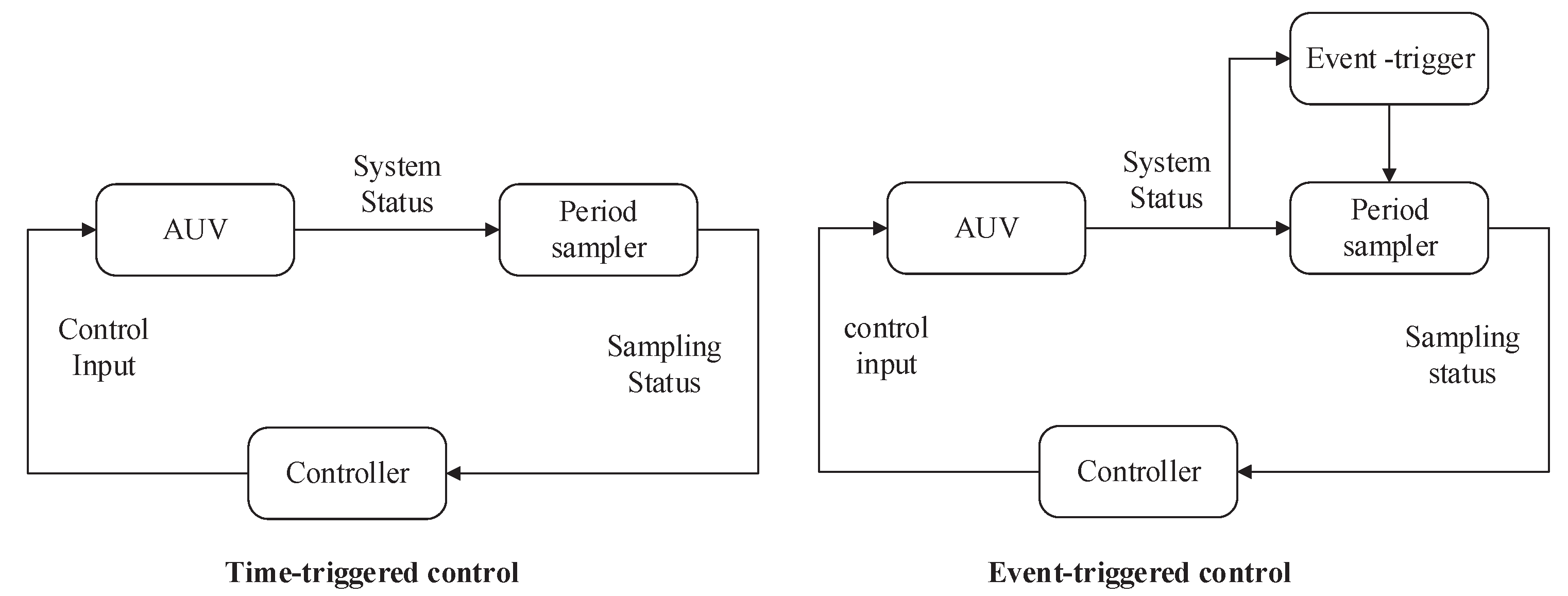
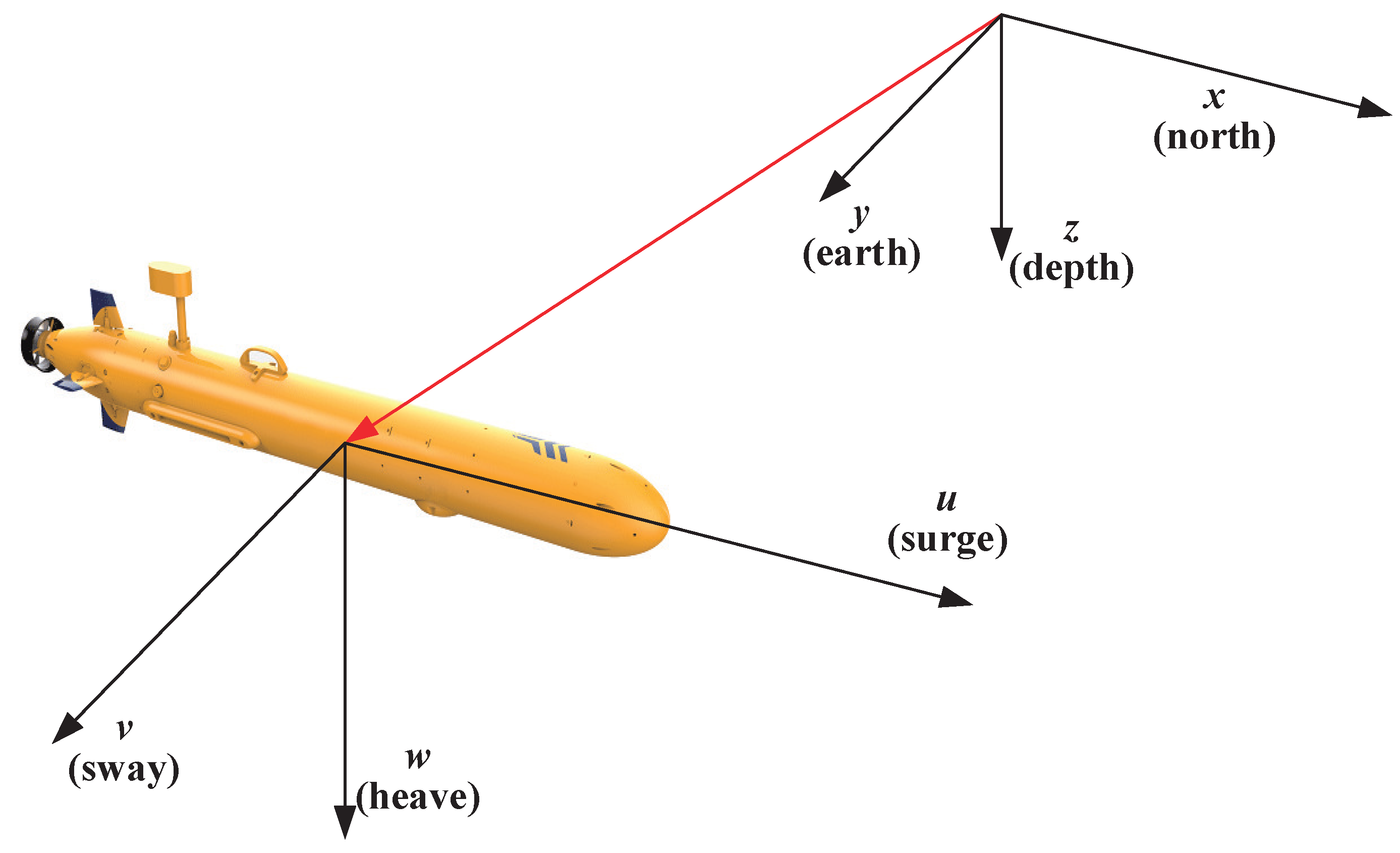
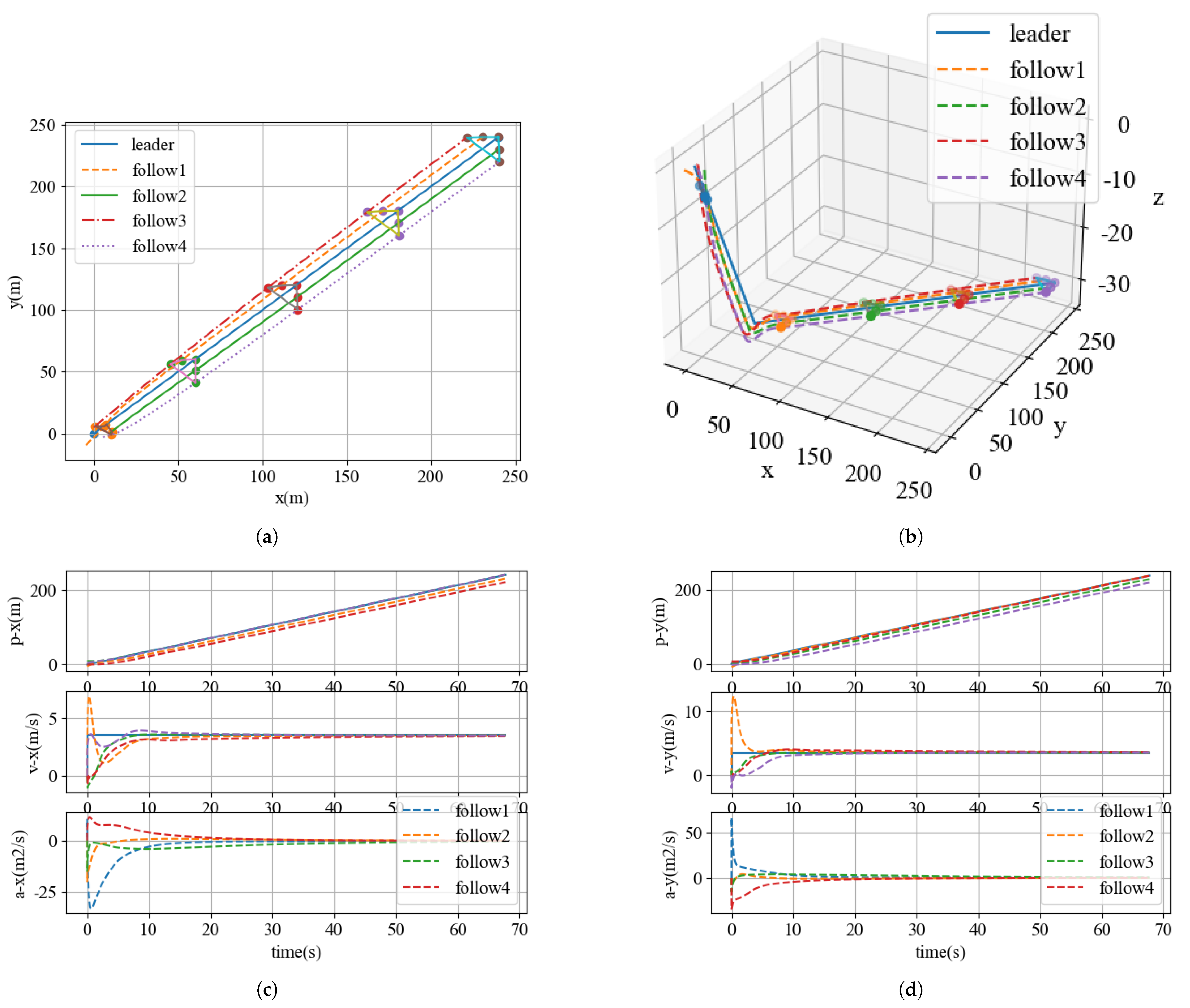
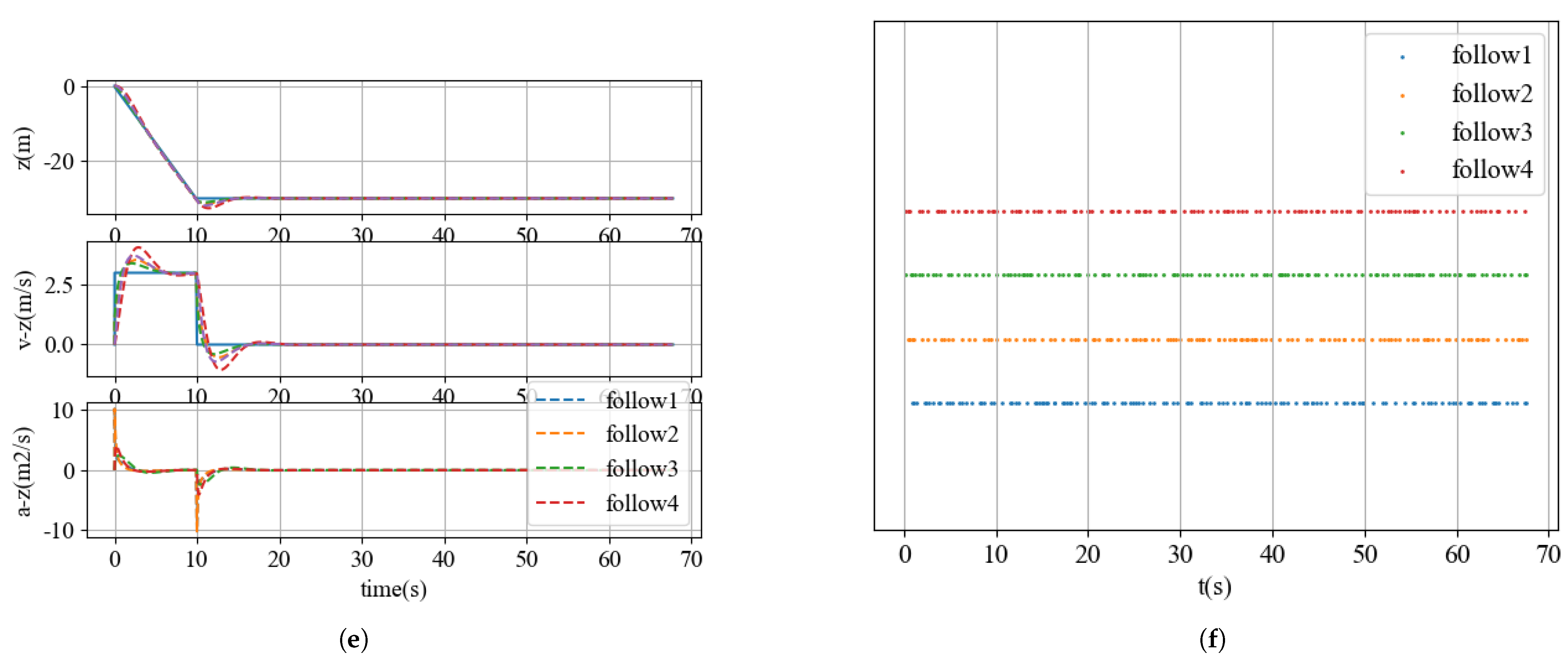
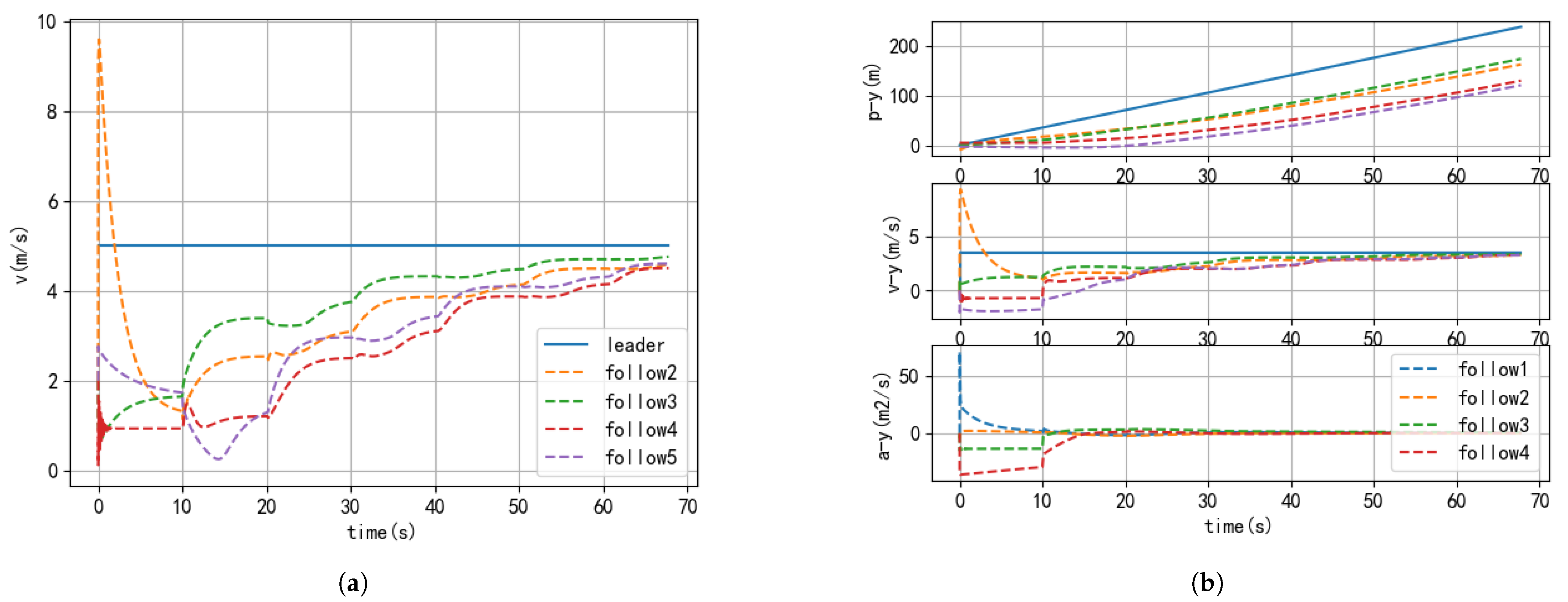
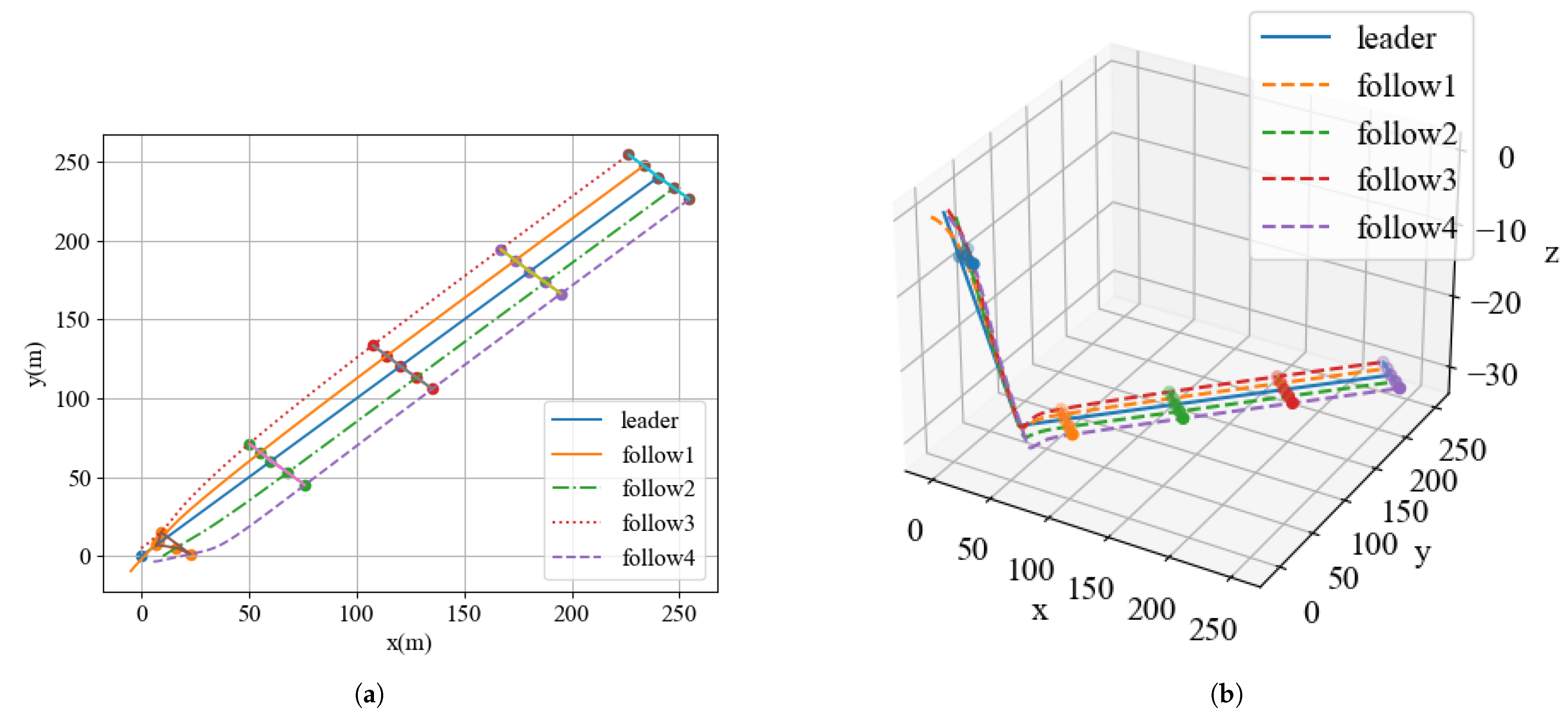
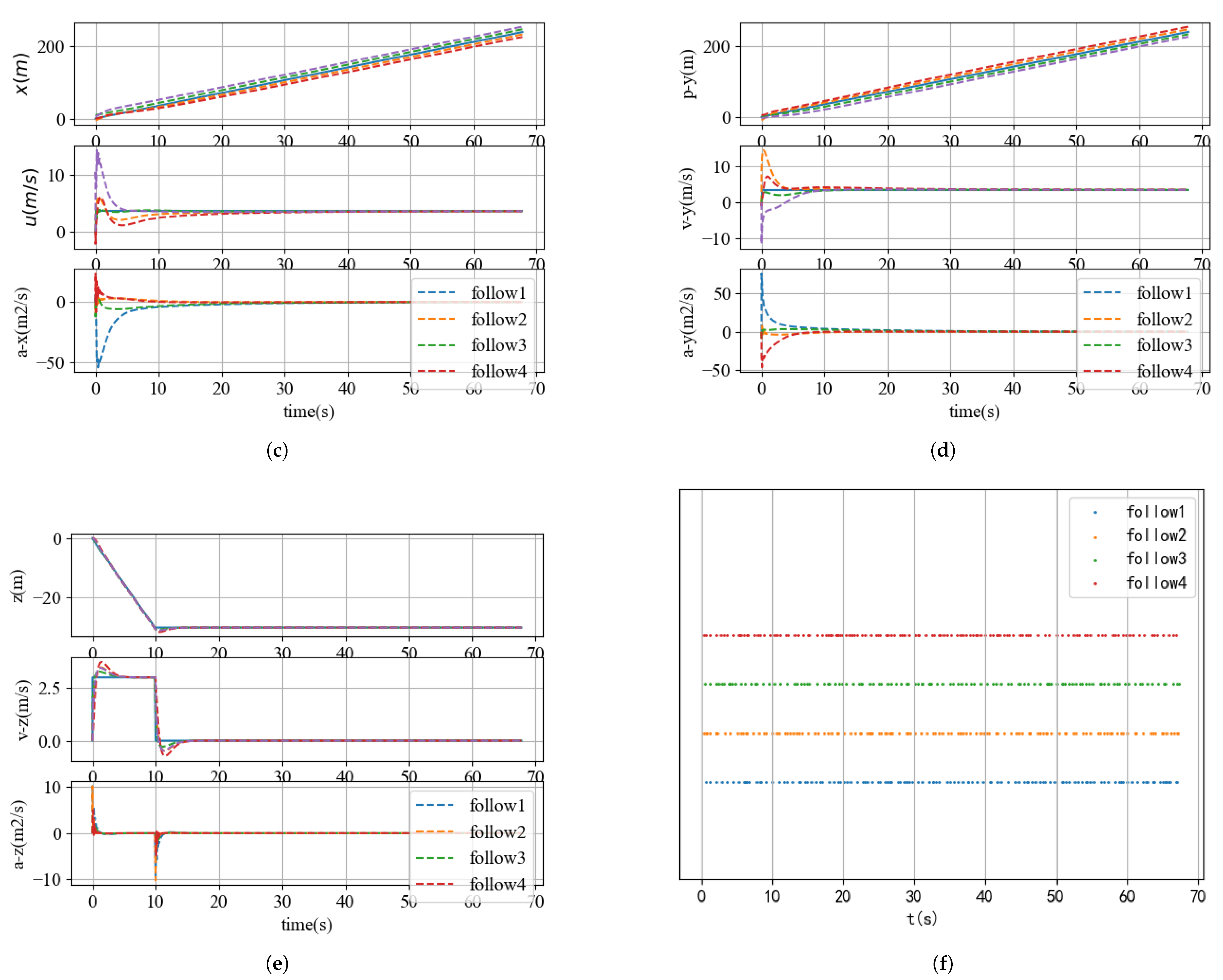
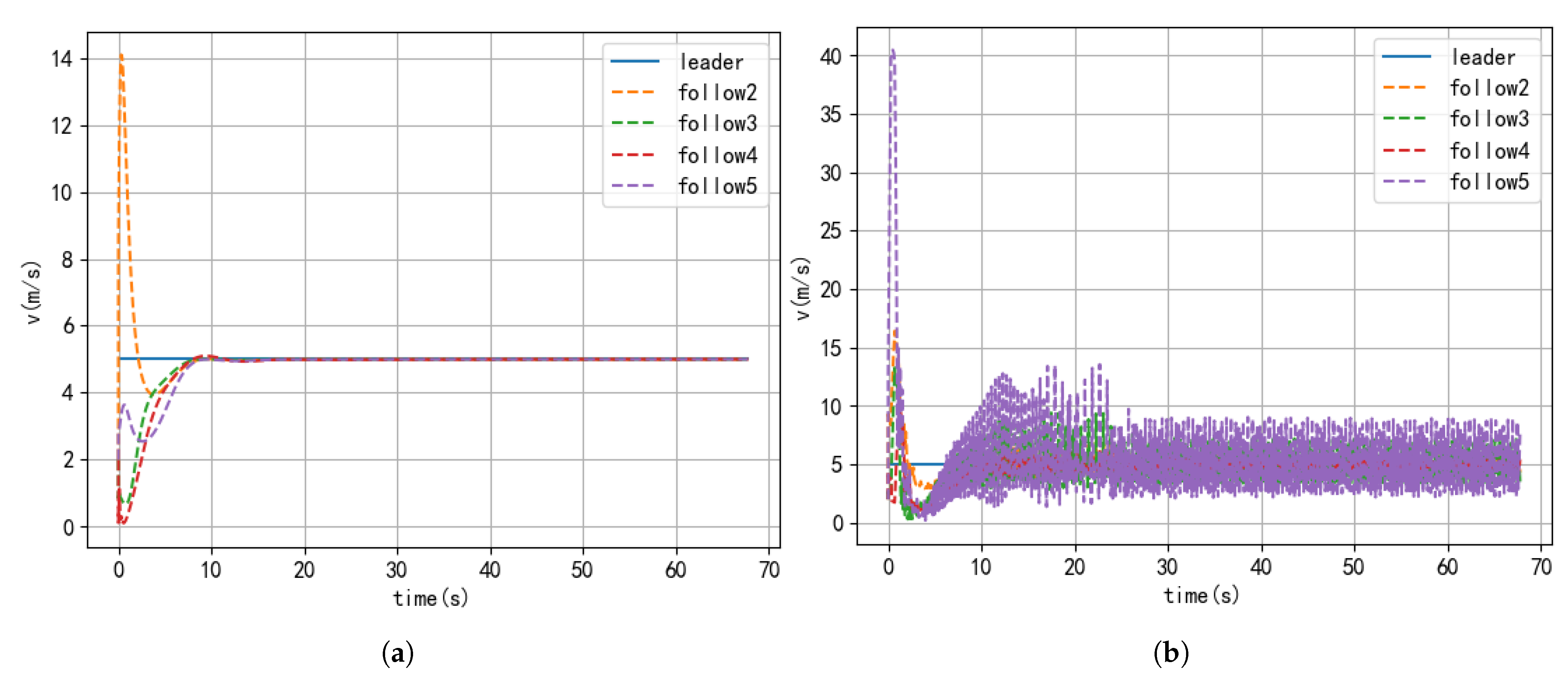
Publisher’s Note: MDPI stays neutral with regard to jurisdictional claims in published maps and institutional affiliations. |
© 2022 by the authors. Licensee MDPI, Basel, Switzerland. This article is an open access article distributed under the terms and conditions of the Creative Commons Attribution (CC BY) license (https://creativecommons.org/licenses/by/4.0/).
Share and Cite
Chen, K.; Luo, G.; Zhou, H.; Zhao, D. Research on Formation Control Method of Heterogeneous AUV Group under Event-Triggered Mechanism. Mathematics 2022, 10, 1373. https://doi.org/10.3390/math10091373
Chen K, Luo G, Zhou H, Zhao D. Research on Formation Control Method of Heterogeneous AUV Group under Event-Triggered Mechanism. Mathematics. 2022; 10(9):1373. https://doi.org/10.3390/math10091373
Chicago/Turabian StyleChen, Ke, Guangyu Luo, Hao Zhou, and Dongming Zhao. 2022. "Research on Formation Control Method of Heterogeneous AUV Group under Event-Triggered Mechanism" Mathematics 10, no. 9: 1373. https://doi.org/10.3390/math10091373
APA StyleChen, K., Luo, G., Zhou, H., & Zhao, D. (2022). Research on Formation Control Method of Heterogeneous AUV Group under Event-Triggered Mechanism. Mathematics, 10(9), 1373. https://doi.org/10.3390/math10091373




